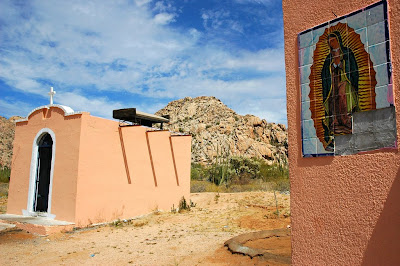Una mujer vestida del sol.
 La Capilla de Nuestra Señora de Guadalupe, Albuquerque, New Mexico (source).
La Capilla de Nuestra Señora de Guadalupe, Albuquerque, New Mexico (source). Roadside shrine, Sonora, Mexico (source).
Roadside shrine, Sonora, Mexico (source). Votives, San Cristóbal de las Casas, Chiapas, Mexico (source).
Votives, San Cristóbal de las Casas, Chiapas, Mexico (source). Tecoh, Yucatán, Mexico (source).
Tecoh, Yucatán, Mexico (source). Somewhere in Mexico (source).
Somewhere in Mexico (source).  In a clothing factory, Guanajuato, Mexico (source).
In a clothing factory, Guanajuato, Mexico (source).  La Virgen y el Buddha (source).
La Virgen y el Buddha (source). Tecoh, Yucatán, Mexico (source).
Tecoh, Yucatán, Mexico (source). Votives, Notre Dame de Paris (source).
Votives, Notre Dame de Paris (source). Betty Boop y la Virgen, Pilsen, Chicago, Illinois (source).
Betty Boop y la Virgen, Pilsen, Chicago, Illinois (source). It's hard for me to know exactly what to write at the start of a post on Our Lady of Guadalupe. On an intellectual level, I fully appreciate the important role that La Virgen de Guadalupe has played in Mexican history and culture. On an affective level, however, Guadalupe doesn't really speak to my heart and soul. Over the years, I've occasionally encountered arguments (in print and in person) to the effect that Guadalupe is a kind of 'universal Madonna' who can unite people of every race, class, culture and language. Far from turning me into a guadalupano, these sort of arguments make me even more resistant to the devotion, both because they seem to promote a kind of homogenization of Marian spirituality and because they almost treat Guadalupe as a sort of mandatory devotion. The Theotokos of Vladimir and the Protecting Veil of the Theotokos stir my soul much more than Guadalupe (or, for that matter, Fatima or Mount Carmel).
To my mind, La Virgen de Guadalupe is no more or less universal than Vladimirskaya or Pokrov or any other local or national Madonna that you may care to name. The point is not that any one image of the Mother of God should speak equally to all believers, but rather that she presents herself in a myriad of ways that appeal to Christians of different races and cultures. Some of these images have become quite ubiquitous, as Guadalupe has become in Mexico and elsewhere. In spite of my lack of devotion to La Morenita, I'll admit that I find the ubiquity of her image quite fascinating. As the above photographs attest, Guadalupe has found a home in rural shrines, on urban street corners, in factories and cathedrals, and even beside statuettes of the Buddha (a novel pairing, to say the very least). On La Morenita's feast day, I extend my prayerful best wishes to guadalupanas and guadalupanos everywhere. AMDG.


0 Comments:
Post a Comment
<< Home